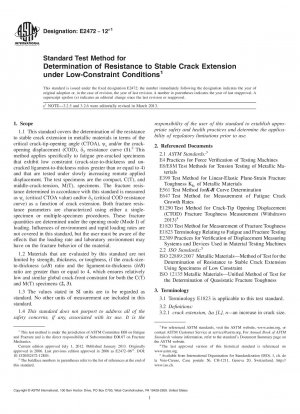ASTM E2472-12e1
Standard Test Method for Determination of Resistance to Stable Crack Extension under Low-Constraint Conditions
- Standard No.
- ASTM E2472-12e1
- Release Date
- 2012
- Published By
- American Society for Testing and Materials (ASTM)
- Status
- Replace By
- ASTM E2472-12(2018)
- Latest
- ASTM E2472-12(2018)e3
- Scope
5.1 This test method characterizes a metallic material’s resistance to stable crack extension in terms of crack-tip-opening angle (CTOA), ψ and/or crack-opening displacement (COD), δ5 under the laboratory or application environment of interest. This method applies specifically to fatigue pre-cracked specimens that exhibit low constraint and that are tested under slowly increasing displacement.
5.2 When conducting fracture tests, the user must consider the influence that the loading rate and laboratory environment may have on the fracture parameters. The user should perform a literature review to determine if loading rate effects have been observed previously in the material at the specific temperature and environment being tested. The user should document specific information pertaining to their material, loading rates, temperature, and environment (relative humidity) for each test.
5.3 The results of this characterization include the determination of a critical, lower-limiting value, of CTOA (ψ c) or a resistance curve of δ5, a measure of crack-opening displacement against crack extension, or both.
5.5 Materials that can be evaluated by this standard are not limited by strength, thickness, or toughness, if the crack-size-to-thickness (a/B) ratio or ligament-to-thickness (b/B) ratio are equal to or greater than 4, which ensures relatively low and similar global crack-front constraint for both the C(T) and M(T) specimens (2, 3).
5.6 The values of CTOA and COD (δ5) determined by this test method may serve the following purposes:
5.6.1 In research and development, CTOA (ψc) or COD (δ5), or both, testing can show the effects of certain parameters on the resistance to stable crack extension of metallic materials significant to service performance. These parameters include, but are not limited to, material thickness, material composition, thermo-mechanical processing, welding, and thermal stress relief.
5.6.3 For inspection and flaw assessment criteria, when used in conjunction with fracture mechanics analyses. Awareness of differences that may exist between laboratory test and field conditions is required to make proper flaw assessment.
5.6.4 The critical CTOA (ψ
ASTM E2472-12e1 Referenced Document
- ASTM E1290 Standard Test Method for Crack-Tip Opening Displacement (CTOD) Fracture Toughness Measurement
- ASTM E1820 Standard Test Method for Measurement of Fracture Toughness
- ASTM E1823 Standard Terminology Relating to Fatigue and Fracture Testing
- ASTM E2309 Standard Practices for Verification of Displacement Measuring Systems and Devices Used in Material Testing Machines
- ASTM E399 Standard Test Method for Plane-Strain Fracture Toughness of Metallic Materials
- ASTM E4 Standard Practices for Force Verification of Testing Machines
- ASTM E561 Standard Practice for R-Curve Determination
- ASTM E647 Standard Test Method for Measurement of Fatigue Crack Growth Rates
- ASTM E8/E8M Standard Test Methods for Tension Testing of Metallic Materials
- ISO 12135 Metallic materials - Unified method of test for the determination of quasistatic fracture toughness
ASTM E2472-12e1 history
- 2018 ASTM E2472-12(2018)e3 Standard Test Method for Determination of Resistance to Stable Crack Extension under Low-Constraint Conditions
- 2018 ASTM E2472-12(2018)e2 Standard Test Method for Determination of Resistance to Stable Crack Extension under Low-Constraint Conditions
- 2018 ASTM E2472-12(2018)e1 Standard Test Method for Determination of Resistance to Stable Crack Extension under Low-Constraint Conditions
- 2018 ASTM E2472-12(2018) Standard Test Method for Determination of Resistance to Stable Crack Extension under Low-Constraint Conditions
- 2012 ASTM E2472-12e1 Standard Test Method for Determination of Resistance to Stable Crack Extension under Low-Constraint Conditions
- 2012 ASTM E2472-12 Standard Test Method for Determination of Resistance to Stable Crack Extension under Low-Constraint Conditions
- 2006 ASTM E2472-06e1 Standard Test Method for Determination of Resistance to Stable Crack Extension under Low-Constraint Conditions
- 2006 ASTM E2472-06 Standard Test Method for Determination of Resistance to Stable Crack Extension under Low-Constraint Conditions

Copyright ©2024 All Rights Reserved